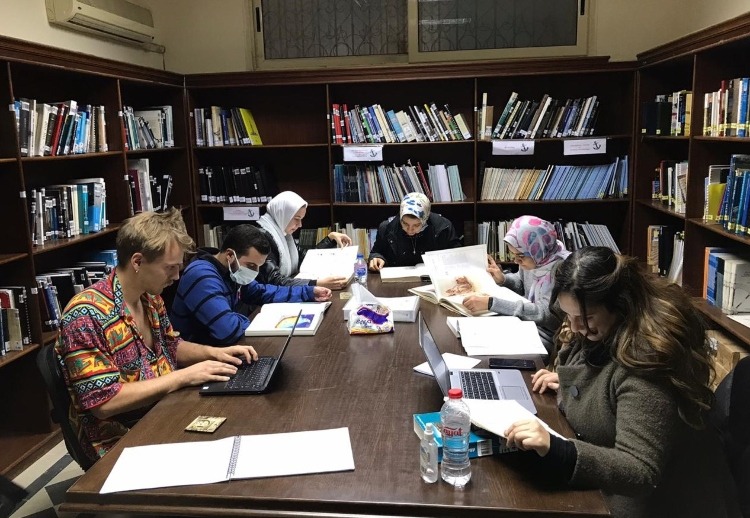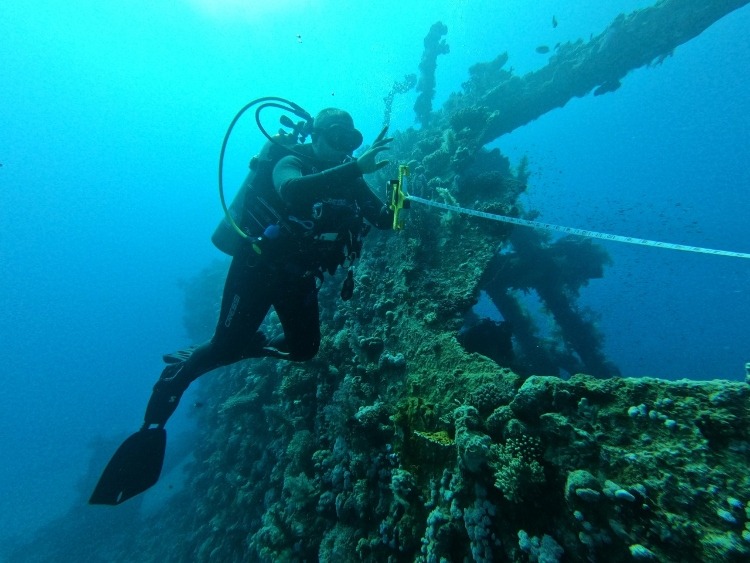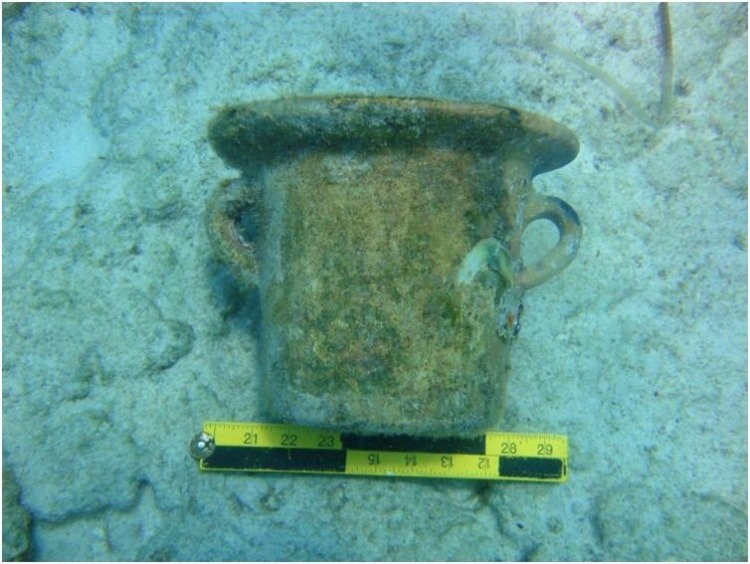Imagine you’re vacationing in Egypt’s Hurghada, on a diving trip in particular, plunging into the deep blue you come across one of the shipwrecks. Questions would come rushing through your head. How old is this boat? Who was on it? Where were they heading? Well, Maritime Archaeologists have got the answers.
The field is basically about studying how humans interact with the sea through the exploration of physical remains like shipwrecks. It helps us learn about human history and culture. Starting in the 1960s, its a relatively new field and it has recently docked at Alexandria, Egypt, with the very first postgraduate center for Maritime Archaeology opening in 2009.
Get to learn about the center and their cool projects through its Director and Founder, Dr. Emad Khalil:
Can you tell me a little about yourself? What got you interested in maritime archaeology?
I’ve always loved to dive and have been diving for a really long time, since 1986. During university, I majored in business, a field that has nothing to do with archaeology. That is why my love and passion for this unique field did not happen between the walls of a lecture hall but rather, it happened in the water. After diving for some time and slowly being exposed to cool archaeological finds, I knew that this is what I wanted to do for the rest of my life. Right after I graduated I made a career shift and began everything from scratch. I had to study Maritime Archaeology abroad as the field did not exist in Egypt during that time. I got my masters in 2002 then my PhD in 2005. That’s when I came back to Egypt.
With my return, I had one goal: to give Egyptians access to the same education.
Can you tell me more about that and the center itself? How did it all start?
In Egypt, not everyone has the luxury to travel. So, I wanted to give people the chance to study Maritime Archaeology without having to move to another country. To me, the biggest obstacle was the funding needed to create this institute from scratch and have it be a part of the University of Alexandria. It’s a large project.
Luckily, at that time, there was a scheme called Tempus run by the European Commission that funds certain projects of any field and specialty. It is very challenging to get funding. Yet, in 2007, I was able to receive a grant to build the institute and that was how it all started.
The center was up and running in 2009. It was the first time a postgraduate educational program was offered for the study of Maritime Archaeology in Egypt and in the Middle East at large. The entire process was very difficult because I was alone, I had to prepare an entire curriculum but now there is a center, there are students and researchers. It’s a whole thing!
What is the importance of the center internationally as well as in the Middle East?
Our work is not merely regional, it’s international. We are actually better known outside of Egypt. We do a lot of our work with UNESCO. We host a UNESCO chair which means we collaborate with them to create diving projects and courses, in an attempt to globally propel the field. For example, UNESCO wanted us to write up a course in Arabic to be taught to students in the Middle East. We also created a few online courses for students abroad. Through UNESCO, we are also in partnership with 32 global universities and constantly collaborate with them. Other than that, 50 of our students have actually travelled on short missions abroad, whether its for 1 week or 1 month to do some training and take part in diving projects.
Overtime, we became part of a very big international network.
Other than your global projects, can you let us know about some of the projects the center does in Egypt?
We have three projects that we do every year. We have one project at the North Coast, near Marsa Matrouh called Marsa Bagoush. This project has been ongoing since 2015 where we survey a Roman site underwater.
It is where you found the Amphorae (Roman Pots)?
Yes. We also do another project in the Red Sea where we study a sunken ship from the 18th century. Our third project is also in the Red Sea, specifically in an area were there is a sunken WWII ship. A lot of tourists would dive near it for pleasure so some of these sites get eroded or deteriorated. So, we would go and perform an assessment of the site.

In terms of the style of work involved in Maritime Archaeology, is it more about diving or more about research and work behind a desk?
In Maritime Archaeology, diving is merely a tool. It plays such a tiny role. The work underwater is very short. Above water is where all the real work happens. All the research in libraries, on computers, just like any science. To give you a proper idea, in one year we spend less than a month diving in comparison to 11 months of research, map making, modelling of artefacts, rendering of artefacts and so on.
So for example, the project for Marsa Bagoush, what’s the process like exactly?
There is a preprocess and post process. We actually found the site for Marsa Bagoush by accident, a year before we started our project. We had to first know if this site is worth further exploration. So, we looked at old maps, old reports and pictures of that site until we discovered that it was actually a 2000-year-old Roman harbor meaning it’s a very important site. That was the preprocess.
Each year, we would dive at the site for 3 weeks. During that time, we’d collect data underwater by taking pictures, measuring the items and documenting their position. Above water, we’d perform the postprocess of downloading all the data onto a computer and going through three to four months of data analysis to figure out the date and origin of each item.

As not many people know about this field, can we talk more about the diving aspect of your projects? How do you know which sites to check out considering that the sea is very big?
Very good question. So, there are three ways we discover these shipwrecks. The main way is by accident. A fisherman may be pulling up a net and randomly find a statue.
The second way is by targeting sites that are known to have been harbors in the past. For example, surveying Alexandria’s water is an example as it is known to have been a port.
The third and hardest way is to make a systematic survey of the entire coast. The UK and Italy use this technique. They would divide their entire coastline into sections. Then each season they would survey a section then scratch it off. Next season they would survey another section and so on. In 20 to 30 years, they would have canvassed the entire coast and would then decide which section they want to re-explore. This is considered the hardest and most expensive technique.
It does not involve actual diving but instead utilizes tools and technology like a sonar system and remote sensing. Once they find something using the sensor then they can actually dive down to explore.
Other than the sonar, what other kinds of tools do you use underwater?
Most people believe that you need to be a multi billionaire to be able to work underwater. However, you can actually do quite a lot using the most basic equipment as simple as a pencil, sheet of paper and scuba gear. In 2009, we started off with basic diving equipment and some measuring tools like measuring tapes, pencils as well as simple cameras.
But as we grew, we got more equipment. Now we have cameras that can take 3D shots as well as 360 degree shots. We will also acquire underwater scooters that kind of look like torpedoes and they will help us survey more of the land. We also bought a small sonar system to add to our boat. We are acquiring equipment as we go.

When you find things underwater, how do you give them an age?
That is pure archaeology. We figure it out from the shape, the material and the design of the item. If it has text inscribed on it that helps as well.
In terms of you, you dove a lot and have been exposed to Maritime Archaeology for years now so what is your favorite fieldwork memory underwater so far?
There is one project that holds a special place in my heart because it represented a big learning curve for me, and it played a big role in how I developed as a person today. I gained so much experience just from that project alone.
It was my first project underwater in 1995. It was one of the most difficult sites I ever dove at. It was near Madinet Sefaga in the Red Sea. 40 meters underwater, there’s a sunken ship dating back to 1750 or 1755.
Its depth made the dive very complicated because you cannot stay underwater for a long time, only a short period of time. If you are diving for 30 minutes, then you need to know exactly what you will do underwater in those 30 minutes before you dive. There is no time to think. It needs to be precisely planned. Then when you finish, you have to handover the work to someone else and they have to know what they need to continue working on once they dive.
The water being very high coupled with harsh weather did not help as well. Neither the fact that to dive at that site, my team and I of 30 people would need to camp out in the middle of nowhere for three entire months. We had to figure out how to get water, electricity and food as the closest city was 20 kms away.
To work at such a difficult site at the start of my career shaped me to this day.
That’s amazing. To wrap things up on a funny note, what was the weirdest thing you discovered underwater?
I was near Marsa Bagoush. I found this piece of pottery and I took a picture of it. It looked like a bucket but was made of clay. It was very unconventional. I’ve never seen anything like it before. For many years I did not know what it was. Then in Cairo, I was doing a presentation about our projects at a French Institute and one of the slides had a picture of that item. I wanted to see if anyone could identify it. On that day, one girl said she did. It turns out it’s a chamber pot. You know, like a potty. On some boats, especially Arab ships, it is very common to find them.

WE SAID THIS: Don’t Forget…Egypt Uncovers 250 Sarcophagus & 150 Statues From 500 B.C.



